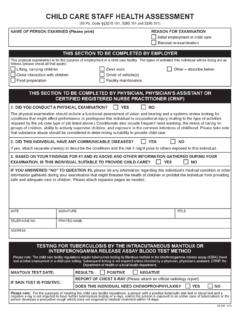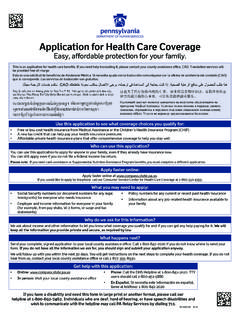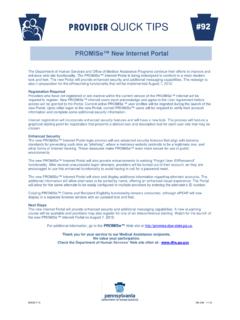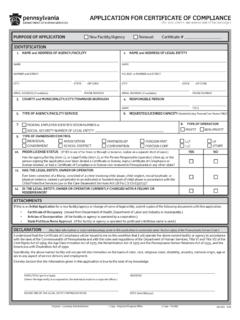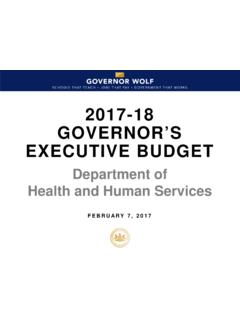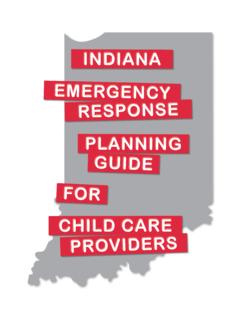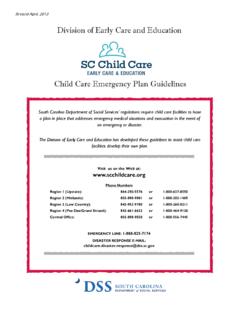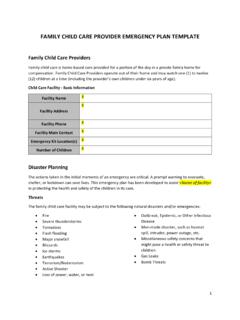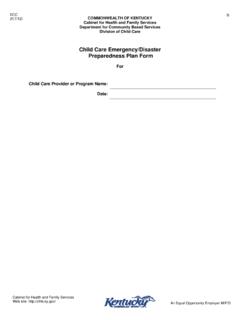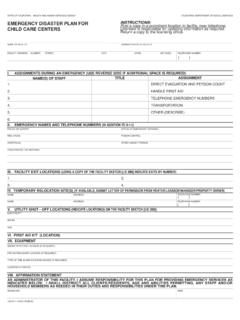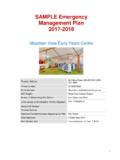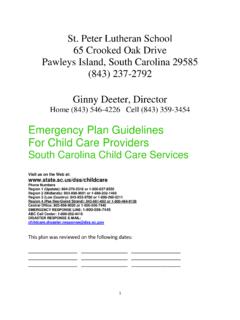Transcription of 2016 Childcare Emergency Disaster Plan
1 Pennsylvania Statewide child care Emergency plan June 30, 2016 Department of Human Services Office of child Development and Early Learning 333 Market Street, 6th Floor, Harrisburg, PA 17126 June 2016 1 An annual review of the Statewide child care Emergency plan is completed by OCDEL and an ad hoc committee of the Early Learning Council. Date of Annual Review: Record of Changes: Date of Change Updated Section(s) Authorized Signature Distribution and Posting The Pennsylvania Statewide child care Emergency plan is a public document. It is posted on the Department of Human Services website under the child care and Early Learning page. Additionally the plan is shared with the following Department of Human Services, Office of child Development and Early Learning partners: The child care Certification Regional Offices The child care Information Services Agencies The Intermediate Units The PA Key The Regional Keys 2 Table of Contents 1.
2 Background & Overview 4 2. Disaster 7 3. Preparedness 8 4. Response 9 5. Recovery 9 6. Subsidy Critical Activities 10 7. Temporary and Emergency child care 12 8. Communication 15 9. Family Reunification 15 Crisis Outreach and Referral Team (DCORT) 16 11. plan Review 16 12. Resources 16 3 Background & Overview Background The Commonwealth of Pennsylvania State Emergency Operations plan (SEOP) is designed to assist state-level leaders and Emergency management personnel in handling all phases of Emergency management during a human caused or natural Disaster . It follows the principles of the National Incident Management System (NIMS) and the Incident Command System (ICS) as specified by the Department of Homeland Security (DHS) and as directed under the Governor s Proclamation on December 20, 2004.
3 It also follows a format similar to the National Response Framework (NRF). All-hazard Emergency management acknowledges that most disasters and emergencies are best managed as a cycle consisting of four phases: prevention, preparedness, response and recovery, with mitigation across all four phases. All- hazard Emergency management also acknowledges that there are common Emergency functional responses. To address these commonalities, the SEOP contains 15 functional annexes, each addressing an Emergency Support Function (ESF). The ESF is a mechanism that consolidates multiple agencies that perform similar or like functions into a single, cohesive unit to allow for the better management of Emergency response functions. The Department of Human Services (DHS) has been tasked as the coordinating agency for Emergency Support Function Six (ESF #6). Emergency Support Function (ESF) #6 Mass care , Shelter, and Human Services coordinates the delivery of Commonwealth mass care , Emergency assistance, housing, and human services when county response and recovery needs exceed their capabilities.
4 DHS s Response and Recovery Framework for Mass care , Shelter and Human Services identify the authority, roles, and responsibilities for DHS executives and program offices to ensure the collective response to disasters and emergencies. Scope In September 2014, the federal child care Development Fund and Block Grant (CCDBG) was reauthorized. In Pennsylvania, CCDBG Act of 2014 provides the funding to support child care , through the Administration for Children and Families, Office of child care to the DHS Office of child Development and Early Learning (OCDEL). These funds, along with the required matching state funds, support child care licensing, child care subsidy and the commonwealth s quality rating and improvement system, Keystone STARS. A key component of the CCDBG Act of 2014 reauthorization was the inclusion in the requirements for participating states to develop and disseminate a Statewide child care Emergency plan .
5 4 In Section 658E(c) (2)(U) of the CCDBG Act of 2014, the Statewide child care Emergency plan must include: Guidelines for continuing child care Development Fund (CCDF) assistance and child care services after a Disaster , which may include provision of temporary child care , and temporary operating standards for Childcare after a Disaster . Requirements that child care providers receiving CCDF have in place procedures for evacuation, relocation, shelter-in-place, lock-down, communication and reunification with families, continuity of operations, accommodation of infants and toddlers, children with disabilities, and children with chronic medical conditions. Requirements that child care providers receiving CCDF have in place procedures for staff and volunteer Emergency preparedness training and practice drills.
6 In order to fulfil the requirement of Section 658, OCDEL has developed the following Statewide child care Emergency plan with the intent to identify and communicate the processes and supports for child care in the event of an individual, local, regional or statewide Emergency or Disaster occurs. It outlines recommendations for planning preparedness, response and recovery from a Disaster and the role the office will play in providing supports. The document provides guidance regarding child care Centers, Groups and Family child care Homes certified by OCDEL and also strives to provide information relevant to all other early learning programs in terms of recommendations and resources. Assumptions The following assumptions were considered in the development of the plan : Emergencies and disasters present themselves in all forms. While some provide advanced warning such as weather related events, others may come about with no warning.
7 The best way to prepare for a Disaster is planning and practice. child care is a necessary component for families and should be restored as quickly as possible. All licensed child care providers are required to develop, provide staff orientation, share with parents, and file an individual Emergency plan with their local municipality and county. DHS is the Coordinating Agency for ESF #6 Mass care , Emergency Assistance, Housing & Human Services when county and regional task forces response and recovery needs exceed their capabilities. As such, DHS maintains plans and protocols for the implementation and management of child care in the event a state-managed shelter was to be activated. This document is a supplement to those plans developed by DHS and the Pennsylvania Emergency Management Agency (PEMA) and does not serve to address the full scope of community or commonwealth response to a Disaster or Emergency .
8 Time frames provided throughout the plan , unless specifically noted serve as guidelines for activities and may vary depending on the circumstance of the Disaster or Emergency . 5 Overview The Office of child Development and Early Learning (OCDEL) is a dual deputate of the Departments of Education and Human Services. As an office, many of the commonwealth s child serving systems are funded or supported by OCDEL staff or business partners. OCDEL serves as Pennsylvania s lead agency for the administration of the child care and Development Fund Block Grant. Additionally OCDEL receives funding through the Office of Head Start for the Head Start State Collaboration Office and from the U. S. Department of Education to support service to children eligible for Early Intervention birth to three and three to school age.
9 Licensed child care The standards to aid in protecting the health, safety and rights of children are found in PA Code Chapter 55, Sections 3270, 3280 and 3290 for child care centers, groups and family child care homes respectively. Those chapters identify the minimum level of compliance necessary to obtain the Department s Certificate of Compliance. Regulatory Amendment - On September 24, 2008, the child care facility regulations were amended to include the requirement for a facility Emergency plan (see 55 Pa. Code , and , relating to Emergency plan ). License-exempt child care The only entities offering child care who are exempt for licensing in Pennsylvania are those entities who meet the definition of Relative established by the language of the CCDF Act of 2014. All other child care providers operating in Pennsylvania must hold a valid Certificate of Compliance. Relatives are considered to be: grandparents, great-grandparents, aunts, uncles, and siblings over the age of 18 who do not live in the child s home.
10 At this time there are no specific Pennsylvania requirements for licensed-exempt providers to have an Emergency plan , but in terms of best practice it is advisable. The Department of Homeland Security as well as the American Red Cross support resources for families Emergency planning. See the Resource section at the end of this document for useful links. child care Subsidies Pennsylvania s child care subsidy program, child care Works, provides financial assistance to low income working families, families receiving Temporary Assistance for Needy Families (TANF), working families that have transitioned off of TANF (Former TANF) and families that participate in unpaid employment and training activities through the Supplemental Nutrition Assistance Program (SNAP). child care Works is administered by local child care Information Services (CCIS) grantees, located throughout the commonwealth. The program pays for child care while parents work or attend approved employment and training programs.
